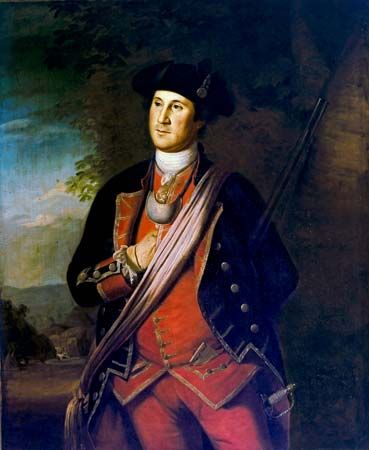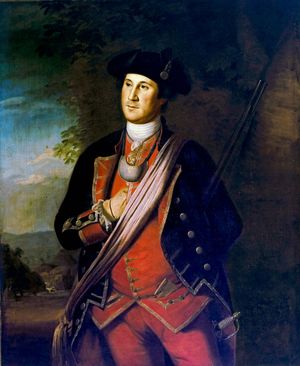Battle of Fort Necessity
Our editors will review what you’ve submitted and determine whether to revise the article.
- Also called:
- Battle of the Great Meadows
- Date:
- July 3, 1754
- Location:
- Pennsylvania
- United States
- Participants:
- France
- United Kingdom
- Context:
- French and Indian War
- Key People:
- George Washington
Battle of Fort Necessity, one of the earliest skirmishes of the French and Indian War, the North American theater of the global Seven Years’ War, and the only battle George Washington ever surrendered. The fight occurred on July 3, 1754, near the site of an earlier skirmish that precipitated it.
The fight at Fort Necessity occurred on the heels of the Battle of Jumonville Glen (May 28), often cited as the opening battle of the French and Indian War. In the earlier skirmish, Washington and his Native American allies had ambushed Joseph Coulon de Villiers, Sieur de Jumonville and his French Canadian forces, which had earlier in the spring taken over a British fort under construction at the convergence of the Allegheny and Monongahela rivers (the “Forks,” at modern-day Pittsburgh). Washington had been sent to demand France’s evacuation of the area and to engage the French forces in battle if necessary. When the French refused to leave, Washington attacked the French from his own headquarters at Great Meadows, south of Fort Duquesne.
After the successful raid, the captured Jumonville was suddenly tomahawked to death by Washington’s ally, Mingo (Iroquoian) chief Tanacharison; nine other French captives were then also scalped. A survivor of the raid escaped back to French headquarters at Fort Duquesne and reported on the massacre. Knowing a counterattack by the French was now only a matter of time, Washington fortified his camp at Great Meadows while he awaited the rest of his volunteer regiment.
When the last companies of the Virginia Regiment arrived on June 9, Washington learned that the colonel had died en route. Promoted to that rank, he took command of the regiment’s 293 officers and men. Washington put his men to work building a small log palisade at Great Meadows, with a low trench and earth berm around the perimeter, which he christened Fort Necessity. It was in a poor location on low ground that was subject to flooding, with the edge of the higher woodlands within musket range. Reinforcements arrived when South Carolina’s Provincial Independent Company marched in with 100 British regulars.
On 3 July, in heavy rain, a force of some 800 French and Native Americans appeared, commanded by Jumonville’s half-brother, Louis Coulon de Villers. Washington formed his men in ranks to fight outside the fort, but this was not what the French force intended. Instead, they surrounded the fort and opened fire from the woods. Four hours later, Washington’s trench was flooded and exposed to enfilade fire, much of his low supply of powder was wet, and many of his men were dead or wounded. At dusk, the French commander called a truce and offered terms. After several hours of negotiation, according to the terms of which the British regulars were allowed to keep their colors and honors of war, Washington, with no hope of reinforcement, signed the surrender (written in French) not realizing that it was also a confession to having “assassinated” Louis’s half-brother at Jumonville Glen. Washington later protested that he would not have signed had the French translator used the word “assassination” and not the comparatively neutral “death.” The two battles in the woods did much to solidify each side’s commitment to war.
At dawn on July 4, a defeated Washington and his surviving men marched out of the fort, which the French then torched, and returned to Virginia. Embarrassed by the surrender but still proud of his actions, Washington later said, “I have heard the bullets whistle; and believe me, there is something charming in the sound.” He would return to the immediate area the following year as part of General Edward Braddock’s ill-fated expedition to attack Fort Duquesne.
Losses: French and Native American, 3 dead, 17 wounded; British, 31 dead, 70 wounded.



























